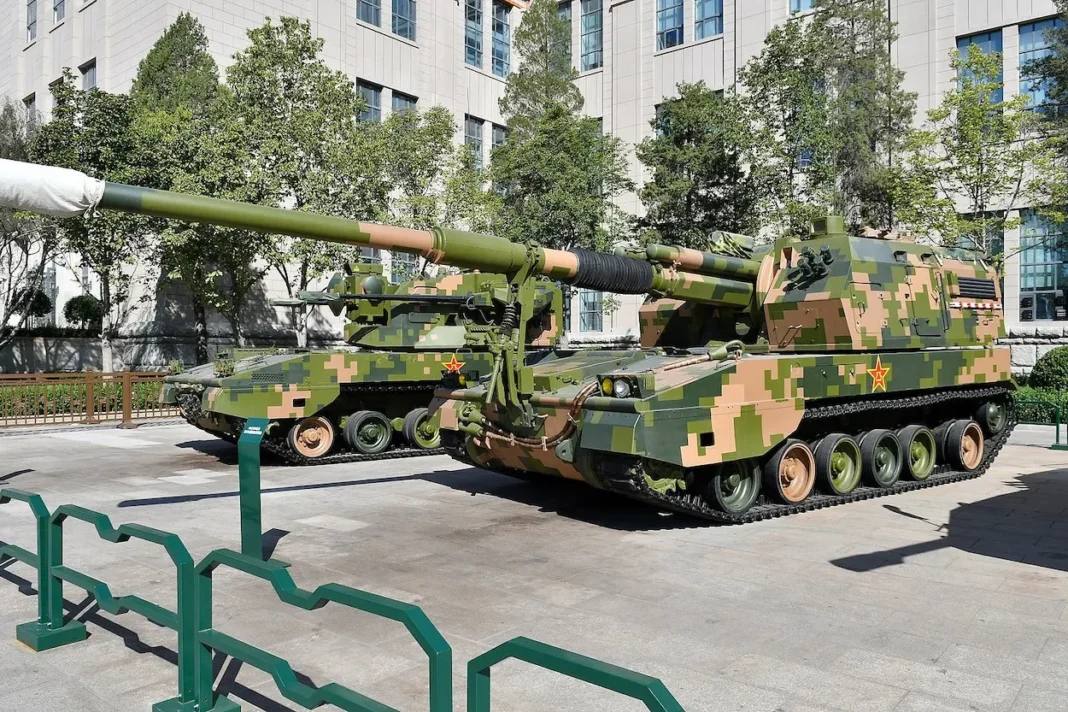Taking notes from both sides’ artillery gunnery practices in the Ukraine war, China may now use artificial intelligence (AI) to help train its big guns against Taiwan.
This month the South China Morning Post reported that a Beijing-based science team had conducted multiple tests of AI-powered laser-guided artillery rounds that can hit human-size targets 16 kilometers away, noting that the precision achieved during the tests exceeded expectations, with photos showing center hits on bullseye targets.
The SCMP said existing guided artillery rounds have limited accuracy due to the vast amount of real-time data that must be computed using traditional mathematical models. It also said that much of this valuable raw data is lost, as microchips in guided artillery rounds should be as simple as possible to withstand the immense shock and heat of being fired from a cannon.
However, the SCMP notes that AI offers the potential for faster data-processing speeds compared with traditional mathematical models and can bypass demanding trajectory calculations using data collected from tests or real firing situations.
It also says the science team used different AI models on several tasks associated with sophisticated trajectory adjustments during flight, improving accuracy via division of labor. The source also noted that with AI, even slow microchips inside guided artillery rounds can do all necessary calculations using all available data.
In a Taiwan scenario, the SCMP notes that AI-powered guided artillery can take out targets in urban areas more efficiently than traditional firepower and at lower costs than missiles. It also says that such precision would prevent collateral damage and civilian casualties and make reconstruction easier.
With those developments, China may be looking to avoid Russia’s artillery mistakes in Ukraine during a potential Taiwan contingency.
Learning from Russian mistakes
In a Forbes article from December last year, David Axe notes that on paper, Russia possesses one of the world’s best artillery-fire control systems, but in practice, poorly trained gunners following rigid and outdated doctrine are wasting Russia’s artillery advantage, firing a lot of rounds without hitting anything, or even resulting in friendly-fire incidents.
Axe notes that all reported contacts are treated as true in Russian gunnery. All fire missions are performed in the order they are received unless higher authorities give orders to prioritize other missions. He says this shows that Russian troops directing fire missions either do not have access to contextual information or are entirely indifferent to it.
In contrast, Axe says that the Ukrainian Army uses the North Atlantic Treaty Organization’s “mission command” concept, which involves following strategic objectives set by higher levels of command while giving lower command levels tactical autonomy.
In practice, Axe notes that Ukrainian artillery shoots, adjusts the aim, and entirely changes the fire schemes when those are not working, as opposed to Russian artillery that keeps shooting while waiting for higher orders to come.
Learning from Russia’s experience, China is integrating artillery with precision capabilities to achieve maximum effect while firing the least number of rounds possible.
Importance of precision
P R Shankar notes in a November 2021 article for MyIndMakers that China perceives offensive firepower, such as artillery, as key to achieving military deterrence, crisis escalation through punitive strikes, paralysis and degradation of the enemy’s systems, and undermining enemy morale.
In connection with that, Shankar also says China repeatedly and increasingly emphasizes the importance of precision strikes according to the adage “the precise controls the imprecise.”
He says China will surgically use precision weapons to control the uncertainty of the battlefield while increasing the same for the adversary, with precision fire strikes disrupting the enemy’s operational tempo.
The US Defense Intelligence Agency’s China Military Power 2019 report says artillery is the critical component of the People’s Liberation Army–Ground Force’s (PLA-GF’s) strike capability, with its primary mission supporting ground assault missions.
The report says that artillery counts for one-third of the PLA-GF’s operational unit strength, with modern artillery systems capable of long-range deployment, firepower operations, and mobile warfare.
The report says China continues to procure modern artillery systems to support the mechanization of PLA-GF artillery while integrating information systems to increase lethality and precision.
China might use precision fire coordinated with robust command and control to achieve strategic effects such as decapitating Taiwan’s command and control instead of mass fire directed at its combat forces.
US reliance on air power
The US may need to catch up because of decades of artillery underinvestment. Michael Peck notes in a January 2022 article in Sandboxx that since the end of World War II, air power has supplanted artillery as the US go-to for heavy firepower.
Peck says artillery lost favor because of being too cumbersome to be deployed in deserts, jungles and mountains, but aircraft had the speed and flexibility to drop heavy ordnance.
Peck said the US saw air power as a means to avoid bloody ground combat that would erode public support for its wars. He also said that the end of the Cold War brought a steady decline in US artillery battalion numbers, with well-trained artillery crews serving as infantry during the Iraq war.
Peck contrasts the US counterinsurgency preoccupation for much of the 2000s with China’s and Russia’s continued artillery modernization. Also, he says that new generations of Chinese and Russian fighter aircraft could deprive US ground forces of air support, which, coupled with the former’s artillery, could prove devastating.
With that underinvestment, US artillery may come up against a host of problems against near-peer adversaries, regional adversaries, and non-state actors.
John Gordon IV and other writers note in a 2019 RAND report that US artillery may be outranged and outnumbered against Russia, lack range and anti-ship capability for a conflict with China, have the insufficient penetrating ability to deal with North Korea’s underground fortifications, lack the volume of fire needed for operations against Iran, and lack the precision needed to avoid civilian casualties when fighting terrorist groups in urban areas.
asiatimes

